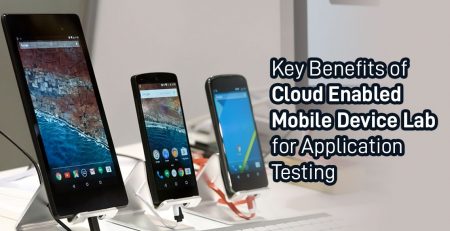Why Testing is important for Success in mCommerce
What is mCommerce?
The trendy Omni channel marketing is leading sales in all the businesses. Whether online or offline, Consumers prefer a seamless, cross-channel shopping experience. However, it’s a known fact that Mobile phones are prominently changing the way consumers shop. Their handy to carry feature plays a major role in probing consumers towards shopping, as users find researching and price comparing from anywhere any time possible and easy using mobiles.
Mobile commerce can be described as ‘business transactions via mobile devices’ or optimizing online business for mobile phones. Mobile commerce (mCommerce) is a term used for selling and buying of goods and services through wireless handheld devices such as mobile phones and personal digital assistants (PDAs). It has popularized next-generation e-commerce as it enables user access to Internet without the need to plug in. A research stated that during the week leading to Christmas, Apple accounted for 51.3% of device activations, the research also suggested that the brand’s devices were popular shopping tools throughout the holidays also.
Mobile acts as a catalyst for sales, though vast majority of retail purchases still happen in stores, the consumer is probed to purchase decision process increasingly through smart phones.
Top 5 Business Benefits of using mCommerce
- Push notifications: 76% of mobile shopping consumers enable push notifications per a survey report. Push notifications improve conversion rate of a business as they target potential customers precisely. mCommerce apps with Push Notifications help bridging the gap between a business and its potential customers by delivering prompt offers and reaching the audience, as mobile is carried almost everywhere.
- Instant contact: Triggering mails and awaiting response creates delay in customer handling. Instant contact from mCommerce helps customers reach business instantly with ease. It also improves accessibility towards business by live chat assistance, one click calling feature and toll-free help desk.
- Complete Access: mCommerce has multiple channels of communication, using which a customer can solve their problems in real time. Demo videos, live chat assistance, detailed pricing, out of stock notification, discount information, service details and everything else customers find handy while shopping, can be integrated into an m-commerce application and bring it within reach of the customers.
- Payments: In-app payment transactions don’t require third-party payment gateways and are hosted by the platform itself. For instance iOS users can pay via Apple Pay, while Android users can pay via Google Wallet.
- Promotional Mediums: “A recent research from eMarketer (July 2015) states that mobile ad spending will propel to 57 billion USD in 2018 which is 29 billion USD more than what it is in June 2015.” Businesses powered via mobile commerce have plethora of opportunities to promote their businesses. It helps marketing go viral by instant customer-reach of discount coupons, special prices for registered customers, daily deals free shipping deals and many more options to earn new customers and improve user registration.
Why is mCommerce testing needed?
Trendy Mobile commerce is now a revolution, which is changing the eCommerce business approach towards customers. Hence businesses failing to provide a mobile-friendly shopping experience might become a major disadvantage.
Image Source : KPCBHowever given the growing popularity of mobile Internet and mobile shopping, mCommerce is a more specific sub-group of eCommerce transactions involving smartphones and tablets. Mobile commerce would only bring a greater businesses value to organizations when tested and quality assured to the users.
Below are few reasons why testing mCommerce is important:
- mCommerce ensures that shopping experiences are well-suited to the smaller screen sizes of smart phones and tablets with responsive designs and a mobile-friendly user experience. Testing mCommerce responsive designs helps avoid delays in uploading.
- According to Mary Meeker’s 2014, 30% of mobile users are smart phone users. Businesses using mCommerce can easily reach the people connecting to Internet using smart phones and tablets. However, if they are dissatisfied with performance due to load, they have more options available.
- Mobile-friendliness is a key factor in purchase decisions and a mobile-unfriendly website drives potential customers away. This was revealed by a study from Google in 2012. According to the study, 67% indicated that a mobile-friendly website probed to buy a product or use a service. Also, 61% indicated that a bad mobile experience made them more likely to leave, this proves that tested user experience improves customer satisfaction.
Challenges in implementing mCommerce
- Payment is one of the most significant barriers in mCommerce, as whenever a visitor prior to completing the transition flips to another webpage, his chances of returning to the website and completing the buying transaction is less. Customers also face difficulty in filling forms for credit card and other required details.
- Customer experience in mobile ecommerce has been overlooked due to increased focus towards excelling in the heavyweight competition. Despite mCommerce investments in creating new business models for selling products, they are failing to succeed due to reduced focus on user experience. So, in the near future, user experience in mobile commerce will need extensive research and investment.
- Un-optimized and responsive-only sites whose page loading is slow create performance issues resulting in visitors leaving the site.
- Good mobile designs of the website must afford the conversion action for the mobile use case.
- Mobiles include tablet phones with varying screen sizes between 4″ and 11″ and have widely varying CPU and bandwidth capabilities. Mostly the fly-away menus are either frustrating or unusable on tablet which makes a site visitor will leave very quickly.
One has to accept that mobile apps with sluggish load times and cluttered interfaces will only push users away. Good quality software with a brilliant user experience is of highest priority for business success of mCommerce. Hence, in order to deliver a great user experience, mobile app developers and testers must continuously improve the quality and velocity of testing practices.
Cigniti’s enterprise mobile lab armed with a comprehensive mobile application testing strategy for getting apps to market on time and within budget, helps increase the customers’ ROI. Cigniti’s mobile testing approach encapsulates the entire software testing life cycle to ensure quality deliverables by leveraging our Mobile TCoE.
For more details, log on to www.cigniti.com or mail to contact@cigniti.com.





Leave a Reply